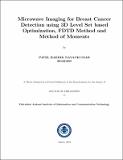Please use this identifier to cite or link to this item:
http://drsr.daiict.ac.in//handle/123456789/793| Title: | Microwave Imaging for Breast Cancer Detection using 3D Level Set based Optimization, FDTD Method and Method of Moments |
| Authors: | Ghodgaonkar, Deepak K. Patel, Hardik Nayankumar |
| Keywords: | Microwave Imaging Diagnos Breast Cancer Non-Ionizing Nature Microwave Radiation Dielectric Breast Tissues Fibro-Glandular Mammography Debye model Breast Phantom Tikhonov 3D FDTD Electric Field Integral Equation EFIE Human Breast Model Matrix Formation Levenberg-Marquardt Algorithms Microwave Tomography Group Theory Antenna MATLAB |
| Issue Date: | 2019 |
| Publisher: | Dhirubhai Ambani Institute of Information and Communication Technology |
| Citation: | Patel, Hardik Nayankumar (2019). Microwave Imaging for Breast Cancer Detection using 3D Level Set based Optimization, FDTD Method and Method of Moments. Dhirubhai Ambani Institute of Information and Communication Technology, xiv, 186 p. (Acc. No: T00758) |
| Abstract: | Microwave imaging is emerging as new diagnostic option for breast cancer detection because of non-ionizing nature of microwave radiation and significant contrast between dielectric properties of healthy and malignant breast tissues. Class III and IV breasts have more than 50% fibro-glandular tissues. So, it is very difficult to detect cancer in class III and IV breasts by using X-ray based mammography. Microwave imaging is very promising for cancer detection in case of dense breasts. Complex permittivity profile of breasts is reconstructed in three dimensions for microwave breast imaging. 3D level set based optimization proposed in this thesis is able to reconstruct proper shape and dielectric property values of breast tissues. Multiple frequency inverse scattering problem formulation improves computational efficiency and accuracy of microwave imaging system because complex number computations are avoided. Measurements of scattered electric fields are taken at five equally spaced frequencies in the range 0.5-2.5 GHz. Class III numerical breast phantom and Debye model are used in multiple frequency inverse scattering problem formulation. There are three unknowns per cell of numerical breast phantom due to Debye model. Linear relationships between Debye parameters are applied to get only static permittivity as unknown per cell of numerical breast phantom. Two level set functions are used to detect breast cancer in 3D level set based optimization. Pixel based reconstruction is replaced by initial guess about static permittivity solution in this modified four stage reconstruction strategy. Frequency hopping method is used to avoid local minima present at particular frequency in the 3D level set based optimization. 3D FDTD solves forward problem efficiently during each iteration of 3D level set method which leads to better reconstruction of static permittivity profile. 3D reconstruction problem is very challenging due to Ill posed system matrix and noisy scattered fields data. Tikhonov and total variation (TV) regularization schemes are used to overcome above challenges. The performance of TV regularization is better than Tikhonov regularization in 3D level set based optimization. TV regularization reconstructs shape and size of very small tumour but it fails to reconstruct exact location of very small tumour. Better 3D reconstruction is achieved by using regularized 3D level set based optimization for at least 20 dB SNR in electric field data. 3D FDTD method based electric field computation in heterogeneous numerical breast phantom is very efficient because it solves Maxwell's equations on grids by using an iterative process. Microwave imaging problem is solved with millions of cells because 3D FDTD is used. Method of moments is used to solve electric field integral equation (EFIE) which estimates complex permittivity of 2048 cell human breast model. Matrix formation and inversion time are reduced to allow large number of cells in breast model. Computational efficiency of the imaging system is improved by exploiting symmetry using group theory. Matrix formed by method of moments is ill posed due to presence of large number of buried cells in inverse scattering formulation. Ill posed system matrix and noise are two major challenges in the solution of inverse scattering problem. Levenberg-Marquardt method is used to solve above challenges. |
| URI: | http://drsr.daiict.ac.in//handle/123456789/793 |
| Appears in Collections: | PhD Theses |
Files in This Item:
| File | Description | Size | Format | |
|---|---|---|---|---|
| 201221005_Patel Hardik Nayankumar.pdf | 201221005 | 2.81 MB | Adobe PDF |  View/Open |
Items in DSpace are protected by copyright, with all rights reserved, unless otherwise indicated.
